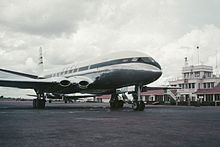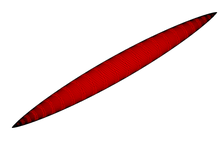Jet aircraft
jet aircraft by Rishabh Sharma on Scribd
 |
Boeing 747-100 of Delta Air Lines |
Whereas the engines in propeller-powered aircraft generally achieve their maximum efficiency at much lower speeds and altitudes, jet engines and aircraft achieve maximum efficiency (see specific impulse) at speeds close to or even well above the speed of sound. Jet aircraft generally cruise at faster than about M 0.8 (609 mph, 981 km/h or 273 m/s) at altitudes around 10,000–15,000 metres (33,000–49,000 ft) or more.
 |
USAF Lockheed Martin F-22 Raptor |
History
 |
Heinkel He 178, in August 1939 the world's first aircraft to fly purely on turbojet power |
The "turbojet", was invented in the 1930s, independently by Frank Whittle and later Hans von Ohain. The first turbojet aircraft to fly was the Heinkel He 178 V1 first prototype of the German Air Force, the Luftwaffe, on August 27, 1939 in Rostock (Germany).
The first flight of a jet engined aircraft to come to popular attention was the Italian Caproni Campini N.1 motorjet prototype that flew on August 27, 1940. It was the first jet aircraft recognised by the Fédération Aéronautique Internationale (at the time the German He 178 program was still kept secret). Campini had proposed the motorjet in 1932.
 |
| Caproni Campini N1 in flight |
The first operational jet fighter was the Messerschmitt Me 262, made by Germany during World War II, entered service on 19 April 1944 with Erprobungskommando 262 at Lechfeld just south of Augsburg, . It was the fastest conventional aircraft of World War II – although there were faster aircraft propelled by unconventional means, such as the rocket-powered Messerschmitt Me 163.
The Messerschmitt Me 262 had first flown on April 18, 1941, with initial plans drawn up by Dr Waldemar Voigt's design team in April 1939, but mass production did not start until early 1944 with the first squadrons operational that year, too late for a decisive effect on the outcome of the war. About the same time, mid 1944, the United Kingdom's Gloster Meteor was being committed to defence of the UK against the V-1 flying bomb – itself a pulsejet-powered aircraft and direct ancestor of the cruise missile– and then ground-attack operations over Europe in the last months of the war. In 1944 Germany introduced into service the Arado Ar 234 jet reconnaissance and bomber, though chiefly used in the former role, with the Heinkel He 162 Spatz single-jet light fighter premiering as 1944 ended. USSR tested its own Bereznyak-Isayev BI-1 in 1942, but the project was scrapped by Joseph Stalin in 1945. The Imperial Japanese Navy also developed jet aircraft in 1945, including the Nakajima J9Y Kikka, a modified, and slightly smaller version of the Me 262 that had folding wings. By the end of 1945, the US had introduced their next jet fighter, the Lockheed P-80 Shooting Star into service and the UK its second fighter design, the de Havilland Vampire.
The US introduced the North American B-45 Tornado, their first jet bomber, into service in 1948. Although capable of carrying nuclear weapons it was used for reconnaissance over Korea.
On November 8, 1950, during the Korean War, United States Air Force Lt. Russell J. Brown, flying in an F-80, intercepted two North Korean MiG-15s near the Yalu River and shot them down in the first jet-to-jet dogfight in history.
The UK put the English Electric Canberra into service in 1951 as a light bomber. It was designed to fly higher and faster than any interceptor.
 |
BOAC Comet 1 was the first passenger jet airliner |
The series of crashes gave time for the Boeing 707 to enter service in 1958 and this came to dominate the market for civilian airliners. The underslung engines were found to be advantageous in the advent of a propellant leak, and so the 707 looked rather different from the Comet: the 707 has a shape that is effectively the same as that of contemporary aircraft, with marked commonality still evident today for example with the 737 (fuselage) and A340 (single deck, swept wing, four below-wing engines).
 |
Boeing 707 |
The Tu-144 supersonic transport was the fastest commercial jet plane at Mach 2.35 (1,555 mph, 2,503 km/h). It went into service in 1975, but soon stopped flying. The Mach 2 Concorde aircraft entered service in 1976 and flew for 27 years.
The fastest military jet plane was the SR-71 Blackbird at Mach 3.35 (2,275 mph, 3,661 km/h).
Other jets
Most people use the term 'jet aircraft' to denote gas turbine based airbreathing jet engines, but rockets and scramjets are both also propelled by jet propulsion.Cruise missiles are single-use unmanned jet aircraft, powered predominately by ramjets or turbojets or sometimes turbofans, but they will often have a rocket propulsion system for initial propulsion.
The fastest airbreathing jet aircraft is the unmanned X-43 scramjet at around Mach 9–10.
The fastest manned (rocket) aircraft is the X-15 at Mach 6.85.
The Space Shuttle, while far faster than the X-43 or X-15, was not regarded as an aircraft during ascent as it was carried ballistically by rocket thrust, rather than the air. During re-entry it was classed (like a glider) as an unpowered aircraft. The first flight was in 1981.
Aerodynamics
 |
The shape of most airliners is usually designed to have nearly the same cross-sectional area at each point along its length as the Sears-Haack body |
Jet aircraft are usually designed using the Whitcomb area rule, which says that the total area of cross-section of the aircraft at any point along the aircraft from the nose must be approximately the same as that of a Sears-Haack body. A shape with that property minimises the production of shockwaves which would waste energy.
Jet engines
Jet engines come in several main types:- turbojet
- turbofan (which come in two main forms low bypass turbofan and high bypass turbofan)
- rocket
The different types are used for different purposes.
Rockets are the oldest type and are mainly used when extremely high speeds or extremely high altitudes are needed. Due to the extreme, typically hypersonic, exhaust velocity and the necessity of oxidiser being carried on board, they consume propellant extremely quickly. For this reason, they are not practical for routine transportation.Turbojets are the second oldest type; it has a high, usually supersonic, exhaust speed and low frontal cross-section, and so is best suited to high-speed, usually supersonic, flight. Although once widely used, they are relatively inefficient compared to turboprop and turbofans for subsonic flight. The last major aircraft to use turbojets were Concorde and Tu-144 supersonic transports.
Low bypass turbofans have a lower exhaust speed than turbojets and are mostly used for high sonic and transonic and low supersonic speeds. High bypass turbofans are used for subsonic aircraft and are quite efficient and are widely used for airliners.
Propulsive efficiency
In aircraft overall propulsive efficiency is the efficiency, in percent, with which the energy contained in a vehicle's propellant is converted into useful energy, to replace losses due to air drag, gravity, and acceleration. It can also be stated as the proportion of the mechanical energy actually used to propel the aircraft. It is always less than 100% because of kinetic energy loss to the exhaust, and less-than-ideal efficiency of the propulsive mechanism, whether a propeller, a jet exhaust, or a fan. In addition, propulsive efficiency is greatly dependent on air density and airspeed.
is the efficiency, in percent, with which the energy contained in a vehicle's propellant is converted into useful energy, to replace losses due to air drag, gravity, and acceleration. It can also be stated as the proportion of the mechanical energy actually used to propel the aircraft. It is always less than 100% because of kinetic energy loss to the exhaust, and less-than-ideal efficiency of the propulsive mechanism, whether a propeller, a jet exhaust, or a fan. In addition, propulsive efficiency is greatly dependent on air density and airspeed.Mathematically, it is represented as
 where
where  is the cycle efficiency and
is the cycle efficiency and  is the propulsive efficiency. The cycle efficiency, in percent, is the proportion of energy that can be derived from the energy source that is converted to mechanical energy by the engine.
is the propulsive efficiency. The cycle efficiency, in percent, is the proportion of energy that can be derived from the energy source that is converted to mechanical energy by the engine. |
Dependence of the propulsive efficiency ( |
where c is the exhaust speed, and v is the speed of the aircraft.
Range
For a long range jet operating in the stratosphere, the speed of sound is constant, hence flying at fixed angle of attack and constant Mach number causes the aircraft to climb, without changing the value of the local speed of sound. In this case:
where
 is the cruise Mach number and
is the cruise Mach number and  the local speed of sound. The range equation can be shown to be:
the local speed of sound. The range equation can be shown to be:
which is known as the Breguet range equation after the French aviation pioneer Louis Charles Breguet.




No comments:
Post a Comment